Realization of Forest Internet of Things Using Wireless Network Communication Technology of Low-Power Wide-Area Network
Abstract
1. Introduction
2. Background and Related Work of LPWAN
2.1. Background
2.2. Related Work to Applications of LPWAN
3. Proposed Forest Sensors and Communication Technology
3.1. NB-IoT Communication Technology and Its Respective Sensors
3.2. LoRa Communication Technology and Its Respective Sensors
4. Experiments and Discussion
4.1. Realization and Experimental Results of NB-IoT Communication
4.2. Realization and Experimental Results of LoRa Repeat Planning for Solving No Signal
5. Conclusions
Author Contributions
Funding
Institutional Review Board Statement
Informed Consent Statement
Data Availability Statement
Conflicts of Interest
References
- Yang, C.-T.; Chen, S.-T.; Yan, Y.-Z. The implementation of a cloud city traffic state assessment system using a novel big data architecture. Clust. Comput. 2017, 20, 1101–1121. [Google Scholar] [CrossRef]
- Yang, C.-T.; Chen, S.-T.; Den, W.; Wu, C.-C. Implementation of an Environmental Quality and Harmful Gases Monitoring System. J. Med. Biol. Eng. 2018, 39, 456–469. [Google Scholar] [CrossRef]
- Baldini, G.; Dimc, F.; Kamnik, R.; Steri, G.; Giuliani, R.; Gentile, C. Identification of mobile phones using the built-in magnetometers stimulated by motion patterns. Sensors 2017, 17, 783. [Google Scholar] [CrossRef]
- Zuo, Z.; Liu, L.; Zhang, L.; Fang, Y. Indoor Positioning Based on Bluetooth Low-Energy Beacons Adopting Graph Optimization. Sensors 2018, 18, 3736. [Google Scholar] [CrossRef] [PubMed]
- Yang, C.-T.; Chen, S.-T.; Liu, J.-C.; Sun, P.-L.; Yen, N.Y. On construction of the air pollution monitoring service with a hybrid database converter. Soft Comput. 2019, 24, 7955–7975. [Google Scholar] [CrossRef]
- Chang, C.-L.; Syu, J.-M.; Chang, C.-Y.; Chen, S.-T. Optimization-based Deployment of Beacons for Indoor Positioning Using Wireless Communications and Signal Power Ranking. IET Commun. 2020, 14, 2915–2923. [Google Scholar] [CrossRef]
- Chang, C.-L.; Chen, S.-T.; Chang, C.-Y.; Jhou, Y.-C. The Application of Machine Learning in Air Hockey Interactive Control System. Sensors 2020, 18, 7233. [Google Scholar] [CrossRef] [PubMed]
- Chang, C.-L.; Tsai, Y.-L.; Chang, C.-Y.; Chen, S.-T. Emergency Evacuation Planning via the Point of View on the Relationship between Crowd Density and Moving Speed. Wirel. Pers. Commun. 2021, 119, 2577–2602. [Google Scholar] [CrossRef]
- Kumar, S.; Nilsen, W.; Pavel, M.; Srivastava, M. Mobile health: Revolutionizing healthcare through transdisciplinary research. Computer 2013, 46, 28–35. [Google Scholar] [CrossRef]
- Chatterjee, P.; Armentano, R.L. Internet of things for a smart and ubiquitous ehealth system. In Proceedings of the 7th International Conference on Computational Intelligence and Communication Networks (CICN), Jabalpur, India, 12–14 December 2015; pp. 178–183. [Google Scholar]
- Verma, P.; Sood, S.K. Cloud-centric IoT based disease diagnosis healthcare framework. J. Ambient. Intell. Humaniz. Comput. 2017, 9, 1293–1309. [Google Scholar] [CrossRef]
- Banka, S.; Madan, I.; Saranya, S.S. Smart Healthcare Monitoring using IoT. Int. J. Appl. Eng. Res. 2018, 13, 11984–11989. [Google Scholar]
- Hassan, H.K.; Abed, J.K.; Waheb, M.A. The IoT for Healthcare Applications. In Proceedings of the IOP Conference Series: Materials Science and Engineering, Fifth Scientific Conference for Engineering and Postgraduate Research (PEC 2020), Baghdad, Iraq, 21–22 December 2020; Volume 1105. [Google Scholar]
- Abbas, S. An innovative IoT service for medical diagnosis. Int. J. Electr. Comput. Eng. 2020, 10, 4918–4927. [Google Scholar] [CrossRef]
- Lin, S.-J.; Chen, S.-T. Enhance the perception of easy-to-fall and apply the Internet of Things to fall prediction and protection. J. Healthc. Commun. 2020, 5, 52. [Google Scholar]
- Hemalathaa, P.; Balajib, S.; Chandruc, E.; Kumard, P.P.; Saravanane, D. Monitoring and Securing the Healthcare Data Harnessing IOT and Blockchain Technology. Turk. J. Comput. Math. Educ. 2021, 12, 2554–2561. [Google Scholar]
- Sahu, M.L.; Atulkar, M.; Ahirwal, M.K. IoT-Based Smart Healthcare System: A Review on Constituent Technologies. J. Circuits Syst. Comput. 2021, 30, 2130008. [Google Scholar] [CrossRef]
- Chen, S.-Y.; Lin, S.-J.; Tsai, M.-C.; Tsai, M.-D.; Tang, Y.-J.; Chen, S.-T.; Wang, L.-H. Patient Confidential Information Transmission Using the Integration of PSO-based Biomedical Signal Steganography and Threshold-based Compression. J. Med. Biol. Eng. 2021, 41, 433–446. [Google Scholar] [CrossRef]
- Frank, A.G.; Dalenogare, L.S.; Ayala, N.F. Industry 4.0 technologies: Implementation patterns in manufacturing companies. Int. J. Prod. Econ. 2019, 210, 15–26. [Google Scholar] [CrossRef]
- Chang, C.-L.; Chang, C.-Y.; Chen, S.-T.; Tu, S.-Y.; Ho, K.-Y. Optimisation-based time slot assignment and synchronisation for TDMA MAC in industrial wireless sensor network. IET Commun. 2019, 13, 2932–2940. [Google Scholar] [CrossRef]
- Chang, C.-L.; Chen, C.-J.; Lee, H.-T.; Chang, C.-Y.; Chen, S.-T. Bounding the Sensing Data Collection Time with Ring-based Routing for Industrial Wireless Sensor Networks. J. Internet Technol. 2020, 21, 673–680. [Google Scholar]
- Tran, K.P. Artificial Intelligence for Smart Manufacturing: Methods and Applications. Sensors 2021, 21, 5584. [Google Scholar] [CrossRef]
- Savale, O.; Managave, A.; Ambekar, D.; Sathe, S. Internet of Things in Precision Agriculture using Wireless Sensor Networks. Int. J. Adv. Eng. Innov. Technol. 2015, 2, 1–5. [Google Scholar]
- Dlodlo, N.; Kalezhi, J. The Internet of Things in Agriculture for Sustainable Rural Development. In Proceedings of the International Conference on Emerging Trends in Networks and Computer Communications 2015, Windhoek, Namibia, 17–20 May 2015. [Google Scholar]
- Mat, I.; Kassim, M.R.M.; Harun, A.N.; Yusoff, I.M. IoT in Precision Agriculture Applications Using Wireless Moisture Sensor Network. In Proceedings of the 2016 IEEE Conference on Open Systems, Langkawi, Malaysia, 10–12 October 2016. [Google Scholar]
- Savića, D.; Vamvakeridou-Lyroudia, L.; Kapelan, Z. Smart Meters, Smart Water, Smart Societies: The iWIDGET Project. In Proceedings of the 16th Conference on Water Distribution System Analysis, WDSA 2014, Bari, Italy, 14–17 July 2014. [Google Scholar]
- Managave, A.; Savale, O.; Ambekar, D.; Sathe, S. Precision Agriculture using Internet of Things and Wireless sensor Networks. Int. J. Adv. Res. Comput. Eng. Technol. 2016, 7, 5. [Google Scholar]
- Yu, Z.; Xugang, L.; Xue, G.; Dan, L. IoT Forest Environmental Factors Collection Platform Based on ZIGBEE. Cybern. Inf. Technol. 2014, 14, 51–62. [Google Scholar] [CrossRef]
- Anitha, K.; Ravi, S. An Overview of Landslide Forecasting Using Wireless Sensor Network and Geographical Information System. Int. J. Eng. Res. Appl. 2016, 6, 70–75. [Google Scholar]
- Suciu, G.; Ciuciuc, R.; Pasat, A.; Scheianu, A. Remote Sensing for Forest Environment Preservation. In Recent Advances in Information Systems and Technologies; Springer: Cham, Switzerland, 2017; pp. 211–220. [Google Scholar] [CrossRef]
- Ganesh, E.N. IOT Based Environment Monitoring using Wireless Sensor Network. Int. J. Adv. Res. 2017, 5, 964–970. [Google Scholar] [CrossRef]
- Döner, Ç.; Şimşek, G.; Yıldırım, K.S.; Kantarc, A. Forest Fire Detection with Wireless Sensor Networks. Bachelor’s Thesis, Ege University, Izmir, Turkey, 2009. [Google Scholar]
- Bolourchi, P.; Uysa, S. Forest Fire Detection in Wireless Sensor Network Using Fuzzy Logic. In Proceedings of the 2013 Fifth International Conference on Computational Intelligence, Communication Systems and Networks, Madrid, Spain, 5–7 June 2013. [Google Scholar]
- Dener, M.; Özkök, Y.; Bostancioglu, C. Fire Detection Systems in Wireless Sensor Networks. In Proceedings of the World Conference on Technology, Innovation and Entrepreneurship, Social and Behavioral Sciences 2015, Istanbul, Turkey, 28–30 May 2015; Volume 195, pp. 1846–1850. [Google Scholar]
- Ma, T.; Liu, Y.; Fu, J.; Jing, Y. Forest Fire Monitoring Based on Mixed Wireless Sensor Networks. Int. J. Smart Home 2015, 9, 169–184. [Google Scholar] [CrossRef]
- Chandrasekharan, R.; Ashiq, M.I.; Prakash, V. Forest Fire Detection using Temperature Sensors Powered by Tree and Auto Alarming using GSM. Int. J. Res. Sci. Innov. 2015, 2, 23–28. [Google Scholar]
- Babiš, M.; Ďuríček, M.; Harvanová, V.; Vojtko, M. Forest Guardian—Monitoring System for Detecting Logging Activities Based on Sound. In Proceedings of the IIT.SRC 2011, Bratislava, Slovakia, 4 May 2011; pp. 1–6. [Google Scholar]
- Sarde, R.K.M.; Kshirsagar, R.V. Development of wireless sensor network (WSN) for remote monitoring of illegal cutting trees in forest. In Proceedings of the International Conference on Advances in Computer Science and Electronics Engineering 2012, Delhi, India, 2–3 February 2012. [Google Scholar]
- Narhari, R.K. AntiSmuggling System for Trees in Forest using Flex Sensor and Zigbee. Int. J. Adv. Res. Comput. Eng. Technol. 2014, 3, 2945–2948. [Google Scholar]
- Muruganantham, K.; Mythili, T.; Thilagavathi, S.; Prabhakaran, R. WSN Based Forest Tree Protection System. South Asian J. Eng. Technol. 2017, 3, 44–50. [Google Scholar]
- Dalvi, A.; Dautapure, M. Undetected Detective to Protect the Forest Trees Against Poaching Using WSN Technology. In Proceedings of the National Conference on Quality Up-Gradation in Engineering, Science and Technology (NC-QUEST018), Dhanamgaon, India, 22 March 2018. [Google Scholar]
- Suguvanam, K.; Kumar, S.; Sarathy, P.; Karthick, K.; Kumar, R. Innovative Protection of Valuable Trees from Smuggling Using RFID and Sensors. Int. J. Innov. Res. Sci. Eng. Technol. 2017, 6, 3836–3845. [Google Scholar]
- Wixted, A.J.; Kinnaird, P.; Larijani, H.; Tait, A.; Ahmadinia, A.; Strachan, N. Evaluation of LoRa and LoRaWAN for Wireless Sensor Networks. Rev. Bras. Ergon. 2016, 9, 10. [Google Scholar]
- Lavric, A.; Petrariu, A.I. LoRaWAN communication protocol: The new era of IoT. In Proceedings of the 14th International Conference on Development and Application Systems (DAS), Suceava, Romania, 24–26 May 2018; pp. 74–77. [Google Scholar]
- Kadir, E.A.; Efendi, A.; Rosa, S.L. Application of LoRa WAN sensor and IoT for environmental monitoring in Riau Province Indonesia. In Proceedings of the 2018 5th International Conference on Electrical Engineering, Computer Science and Informatics (EECSI), Malang, Indonesia, 16–18 October 2018; pp. 281–285. [Google Scholar]
- Nashiruddin, M.I.; Winalisa, S. Designing LoRaWAN Internet of Things Network for Smart Manufacture in Batam Island. In Proceedings of the 2020 8th International Conference on Information and Communication Technology (ICoICT), Yogyakarta, Indonesia, 24–26 June 2020. [Google Scholar]
- Queralta, J.P.; Gia, T.N.; Zou, Z.; Tenhunen, H.; Westerlund, T. Comparative Study of LPWAN Technologies on Unlicensed Bands for M2M Communication in the IoT: Beyond LoRa and LoRaWAN. Procedia Comput. Sci. 2019, 155, 343–350. [Google Scholar] [CrossRef]
- Siddique, A.; Prabhu, B.; Chaskar, A.; Pathak, R. A Review on Intelligent Agriculture Service Platform with Lora Based Wireless Sensor Network. Int. Res. J. Eng. Technol. 2019, 6, 2539–2542. [Google Scholar]
- Chen, S.-T.; Hua, C.-C.; Chuang, C.-C. Forest Management using Internet of Things in the Fushan Botanical Garden in Taiwan. J. Adv. Inn Artif. Life Robot. 2021, 2, 78–82. [Google Scholar]
- Apriani, Y.; Oktaviani, W.A.; Sofian, I.M. Design and Implementation of LoRa-Based Forest Fire Monitoring System. J. Robot. Control. 2020, 3, 236–243. [Google Scholar] [CrossRef]
- Prasad, S.J.S.; Thangatamilan, M.; Suresh, M.; Panchal, H.; Rajan, C.A.; Sagana, C.; Gunapriya, B.; Sharma, A.; Panchal, T.; Sadasivuni, K.K. An efficient LoRa-based smart agriculture management and monitoring system using wireless sensor networks. Int. J. Ambient. Energy 2022, 43, 5447–5450. [Google Scholar] [CrossRef]
- Sendra, S.; Parra, L.; Jimenez, J.M.; Garcia, L.; Lloret, J. LoRa-based network for water quality monitoring in coastal areas. Mob. Netw. Appl. 2022, 1–17. [Google Scholar] [CrossRef]

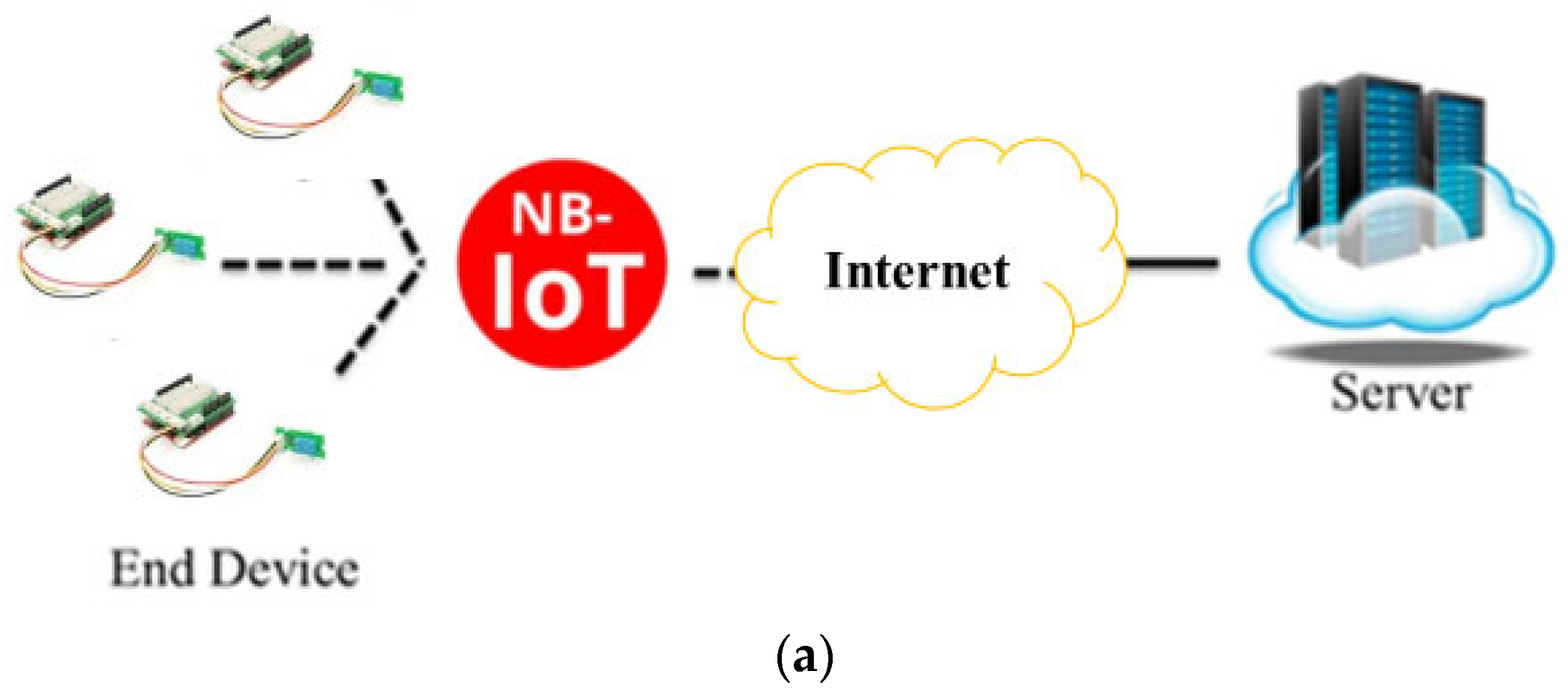



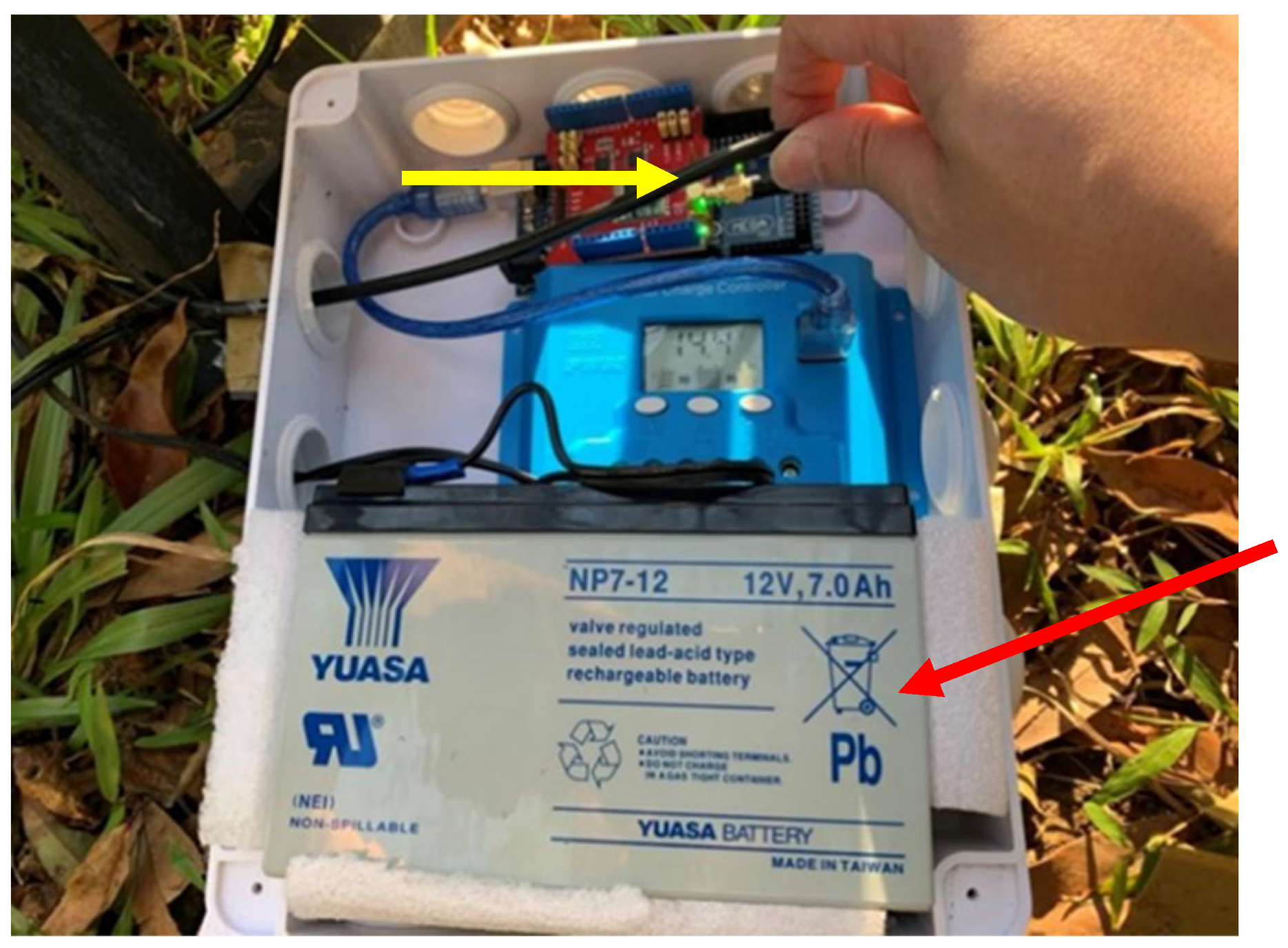
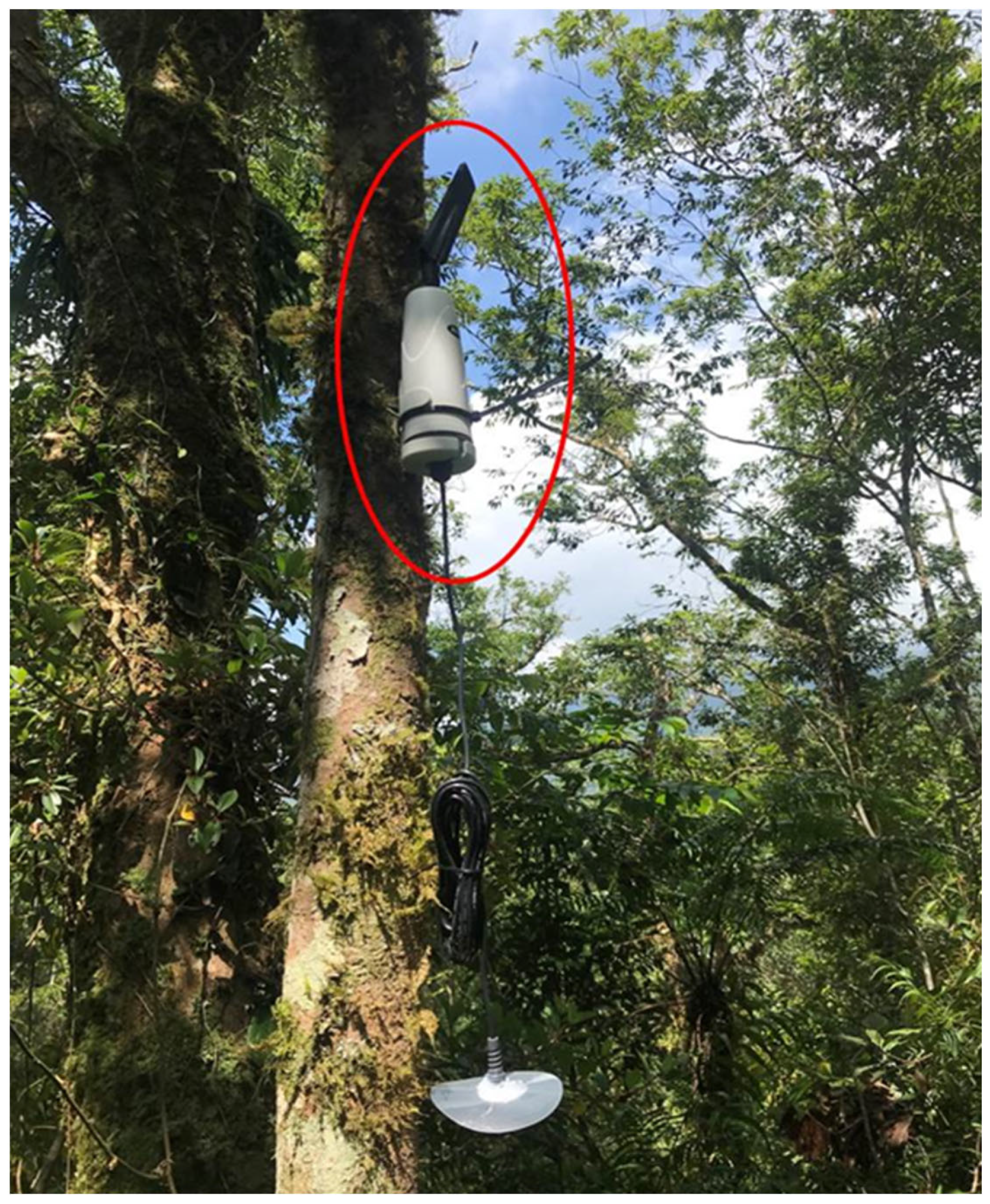


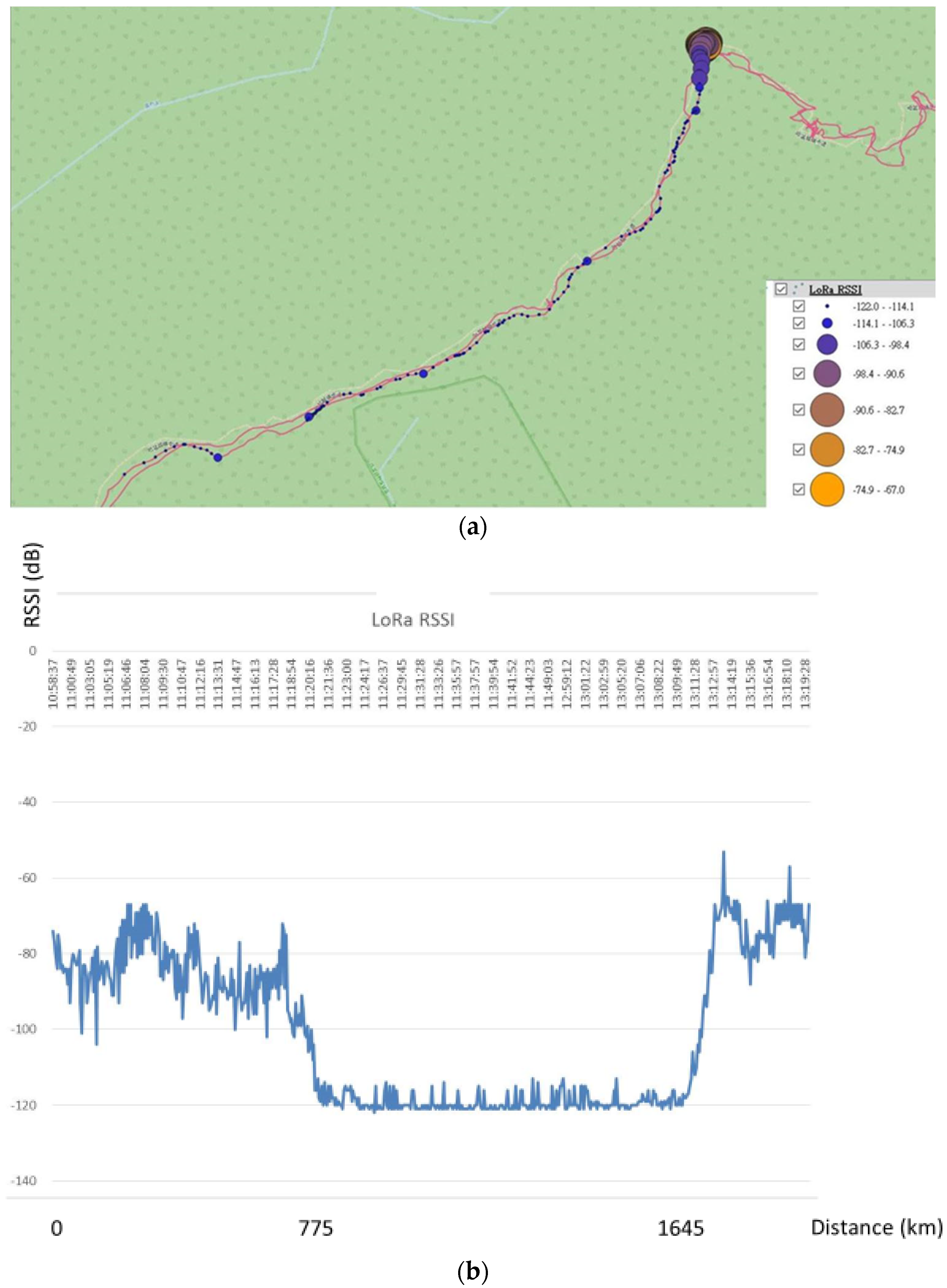
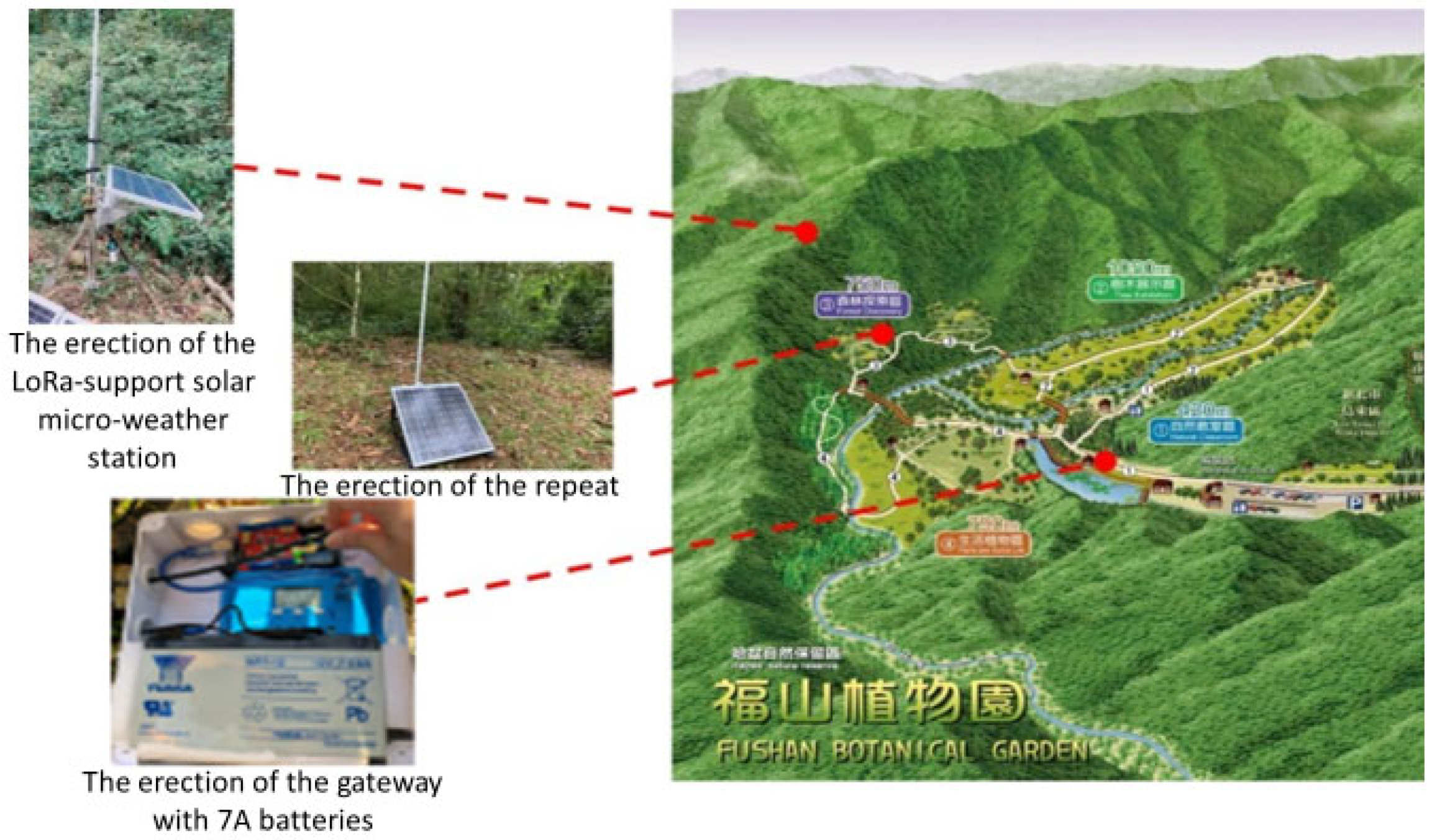

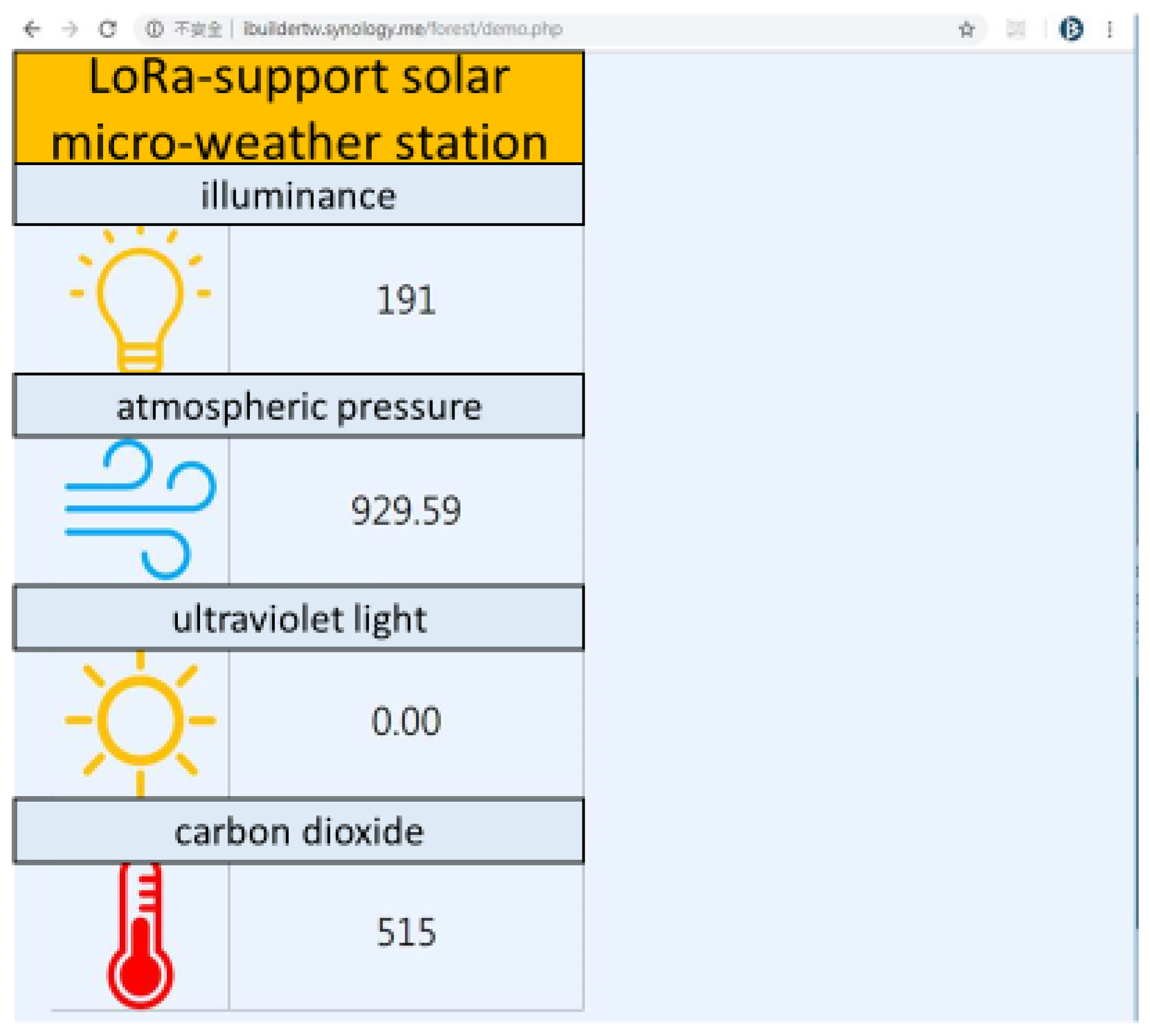

| Technical Protocol | Promoter | Established Year | Number of Base Station Connections | Frequency Band Used | Transmission Distance | Transmission Speed | Technical Category |
|---|---|---|---|---|---|---|---|
| Sigfox | Sigfox | 2009 | 1,000,000 | ISM band, sub-1 GHz | Urban area, 10 km; outskirts, 50 km | 100 bps | Terminal device to front-end application |
| LoRaWAN | IBM, CISCO | 2015 | 250,000 | ISM band, sub-1 GHz | Urban area, 3–5 km; outskirts, 15 km | 300 bps–50 kbps | Communication protocol |
| Weightless | ARM, NEUL | 2015 | 1,000,000 | ISM band, sub-1 GHz | 5 km+(-N) 2 km+(-P) | 30–100 kbps(-N) 100 kbps(-P) | Communication protocol |
| NB-IoT | 3GPP | 2016 | 100,000 | GSM or LTE band | 20 km | ~50 kbps | Communication protocol |
| Method | Signal Repeat Station | External Battery | Using NB-IoT in Areas with 3G/4G Telecommunication Signal | Consideration of Heavy Rain |
|---|---|---|---|---|
| Reference [43] | No | No | No | No |
| Reference [44] | No | No | No | No |
| Reference [45] | No | No | No | No |
| Reference [46] | No | No | No | No |
| Reference [47] | No | No | No | No |
| Reference [48] | No | No | No | No |
| Reference [49] | Yes | No | Yes | No |
| Reference [50] | No | No | No | No |
| Reference [51] | No | No | No | No |
| Reference [52] | No | No | No | No |
| The proposed method | Yes | Yes | Yes | Yes |
| Distance (km) | RSSI on Mountain Slope 1 | RSSI on Mountain Slope 2 | RSSI on Mountain Slope 3 | RSSI on Mountain Slope 4 |
|---|---|---|---|---|
| 0.1 | −64 dBm | −63 dBm | −62 dBm | −63 dBm |
| 0.2 | −68 dBm | −70 dBm | −67 dBm | −69 dBm |
| 0.3 | −74 dBm | −75 dBm | −71 dBm | −72 dBm |
| 0.4 | −83 dBm | −83 dBm | −80 dBm | −78 dBm |
| 0.5 | −104 dBm | −102 dBm | −103 dBm | −101 dBm |
| 0.6 | −122 dBm | −121 dBm | −122 dBm | −120 dBm |
| Distance (km) | RSSI on Mountain Slope 1 | RSSI on Mountain Slope 2 | RSSI on Mountain Slope 3 | RSSI on Mountain Slope 4 |
|---|---|---|---|---|
| 0.1 | −77 dBm | −78 dBm | −76 dBm | −75 dBm |
| 0.2 | −81 dBm | −80 dBm | −79 dBm | −81 dBm |
| 0.3 | −90 dBm | −89 dBm | −87 dBm | −89 dBm |
| 0.4 | −98 dBm | −96 dBm | −97 dBm | −98 dBm |
| 0.5 | −118 dBm | −120 dBm | −121 dBm | −119 dBm |
| 0.6 | −132 dBm | −131 dBm | −132 dBm | −130 dBm |
| Distance (km) | RSSI at Mountain Edge 1 | RSSI at Mountain Edge 2 | RSSI at Mountain Edge 3 |
|---|---|---|---|
| 0.6 | −63 dBm | −67 dBm | −64 dBm |
| 0.7 | −70 dBm | −70 dBm | −69 dBm |
| 0.8 | −73 dBm | −75 dBm | −74 dBm |
| 0.9 | −78 dBm | −80 dBm | −79 dBm |
| 1.0 | −80 dBm | −79 dBm | −83 dBm |
| 1.1 | −96 dBm | −95 dBm | −93 dBm |
| 1.2 | −121 dBm | −122 dBm | −120 dBm |
| 1.3 | −129 dBm | −130 dBm | −131 dBm |
Disclaimer/Publisher’s Note: The statements, opinions and data contained in all publications are solely those of the individual author(s) and contributor(s) and not of MDPI and/or the editor(s). MDPI and/or the editor(s) disclaim responsibility for any injury to people or property resulting from any ideas, methods, instructions or products referred to in the content. |
© 2023 by the authors. Licensee MDPI, Basel, Switzerland. This article is an open access article distributed under the terms and conditions of the Creative Commons Attribution (CC BY) license (https://creativecommons.org/licenses/by/4.0/).
Share and Cite
Zhao, M.; Ye, R.-J.; Chen, S.-T.; Chen, Y.-C.; Chen, Z.-Y. Realization of Forest Internet of Things Using Wireless Network Communication Technology of Low-Power Wide-Area Network. Sensors 2023, 23, 4809. https://doi.org/10.3390/s23104809
Zhao M, Ye R-J, Chen S-T, Chen Y-C, Chen Z-Y. Realization of Forest Internet of Things Using Wireless Network Communication Technology of Low-Power Wide-Area Network. Sensors. 2023; 23(10):4809. https://doi.org/10.3390/s23104809
Chicago/Turabian StyleZhao, Ming, Ren-Jie Ye, Shuo-Tsung Chen, Yen-Chun Chen, and Zi-Yu Chen. 2023. "Realization of Forest Internet of Things Using Wireless Network Communication Technology of Low-Power Wide-Area Network" Sensors 23, no. 10: 4809. https://doi.org/10.3390/s23104809
APA StyleZhao, M., Ye, R.-J., Chen, S.-T., Chen, Y.-C., & Chen, Z.-Y. (2023). Realization of Forest Internet of Things Using Wireless Network Communication Technology of Low-Power Wide-Area Network. Sensors, 23(10), 4809. https://doi.org/10.3390/s23104809






